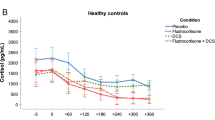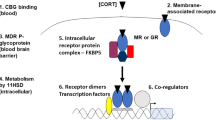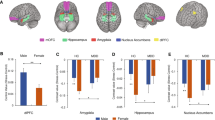Abstract
In severely depressed patients, emotional arousal, cognitive abnormality and vulnerability to psychotic episodes are linked to a hyperactive hypothalamic–pituitary–adrenal (HPA) axis and high levels of circulating cortisol. The susceptibility pathways underlying these disturbed brain functions are influenced by genetic factors, early-life priming experiences and later-life events. Cortisol is an important determinant in this so-called three hit model. The action of cortisol is protective, but can become harmful if exposure of susceptibility pathways to the stress hormone is excessive and sustained or inadequate. In this article we argue that this change in role of cortisol from protective into harmful depends on the functioning of the mineralocorticoid and glucocorticoid receptors and the context in which the organism experiences the stressor. Actions mediated by the mineralocorticoid and glucocorticoid receptors are complementary and operate in different time domains of the stress response: the mineralocorticoid receptor normally prevents stress-induced disturbances, but if such disturbances occur the glucocorticoid receptor helps the recovery process. An imbalance in these receptor-mediated actions is thought to increase vulnerability to stress-related psychiatric disorders in predisposed individuals. Correction of the imbalance between the mineralocorticoid receptor and the glucocorticoid receptor can, therefore, facilitate recovery processes still present in the diseased brain, provided that the right psychological context is offered to the individual.
Key Points
-
Corticosteroid action in the brain is mediated by the high-affinity mineralocorticoid receptors, which protect neurons in stress, and lower-affinity glucocorticoid receptors, which promote recovery of neurons
-
Corticosteroids are generally protective but become harmful in excessive or inadequate concentrations, a change that is thought to depend on the context in which the mineralocorticoid and glucocorticoid receptors operate in pathways susceptible to stress in the brain
-
The maturation of susceptibility pathways depends on genetic factors and can be shaped by epigenetic processes that depend on the maternal environment
-
Targets for intervention in phenotypes vulnerable to stress-related psychiatric disorders are found in corticosteroid-responsive susceptibility pathways in the brain; potential drugs include specific ligands for the receptors, which in future may discriminate between different modes of action—at the level of membranes, gene transactivation and transrepression
This is a preview of subscription content, access via your institution
Access options
Subscribe to this journal
Receive 12 print issues and online access
$209.00 per year
only $17.42 per issue
Buy this article
- Purchase on Springer Link
- Instant access to full article PDF
Prices may be subject to local taxes which are calculated during checkout



Similar content being viewed by others
References
Murray CJ and Lopez AD (1997) Alternative projections of mortality and disability by cause 1990-2020: Global Burden of Disease Study. Lancet 349: 1498–1504
Gold PW et al. (2002) Divergent endocrine abnormalities in melancholic and atypical depression: clinical and pathophysiologic implications. Endocrinol Metab Clin North Am 31: 37–62
Thakore J (Ed.; 2001) Physical Consequences of Depression. Philadelphia: Wrightson Biomedical Publishing
Berton O and Nestler EJ (2006) New approaches to antidepressant drug discovery: beyond monoamines. Nat Rev Neurosci 7: 137–151
Sullivan PF et al. (2000) Genetic epidemiology of major depression: review and meta-analysis. Am J Psychiatry 157: 1552–1562
Heim C and Nemeroff CB (2001) The role of childhood trauma in the neurobiology of mood and anxiety disorders: preclinical and clinical studies. Biol Psychiatry 49: 1023–1039
Rinne T et al. (2002) Hyperresponsiveness of hypothalamic-pituitary-adrenal axis to combined dexamethasone/corticotropin-releasing hormone challenge in female borderline personality disorder subjects with a history of sustained childhood abuse. Biol Psychiatry 52: 1102–1112
Caspi A et al. (2003) Influence of life stress on depression: moderation by a polymorphism in the 5-HTT gene. Science 301: 386–389
de Kloet ER et al. (2005) Stress and the brain: from adaptation to disease. Nat Rev Neurosci 6: 463–475
Kendler S et al. (1999) Causal relationship between stressful life events and the onset of major depression. Am J Psychiatry 156: 837–841
Holsboer F (2000) The corticosteroid receptor hypothesis of depression. Neuropsychopharmacology 23: 477–501
van Praag HM et al. (2004) Stress, the Brain and Depression. Cambridge, UK: Cambridge University Press
Nemeroff CB and Vale WW (2005) The neurobiology of depression: inroads to treatment and new drug discovery. J Clin Psychiatry 66: 5–13
Modell S et al. (1998) Hormonal response patterns in the combined Dex-CRH test is stable over time in subjects at high familial risk for affective disorders. Neuropsychopharmacology 18: 253–262
Gomez RG et al. (2006) The neuropsychological profile of psychotic major depression and its relation to cortisol. Biol Psychiatry 60: 472–478
van der Lely AJ et al. (1991) Rapid reversal of acute psychosis in the Cushing syndrome with the cortisol-receptor antagonist mifepristone (RU 486). Ann Intern Med 114: 143–144
Schatzberg AF et al. (1984) A corticosteroid/dopamine hypothesis for psychotic depression and related states. J Psychiatr Res 19: 57–64
Binder EB et al. (2004) Polymorphism in FKBP5 are associated with increased recurrence of depressive episodes and rapid response to antidepressant treatment. Nat Genet 36: 1319–1325
van Rossum EFC et al. (2006) Polymorphisms of the glucocorticoid receptor gene and major depression. Biol Psychiatry 59: 681–688
McEwen BS (2004) Protection and damage from acute and chronic stress: allostasis and allostatic overload and relevance to the pathophysiology of psychiatric disorders. Ann NY Acad Sci 1032: 1–7
Müller MB et al. (2003) Limbic corticotropin-releasing hormone receptor 1 mediates anxiety-related behavior and hormonal adaptation to stress. Nat Neurosci 6: 1100–1107
Tomlinson JW and Stewart PM (2005) Mechanisms of disease: selective inhibition of 11β-hydroxysteroid dehydrogenase type I as a novel treatment for the metabolic syndrome. Nat Clin Pract Endocrinol Metab 1: 92–99
Karssen AM et al. (2005) Low doses of dexamethasone can produce a hypocorticosteroid state in the brain. Endocrinology 146: 5587–5595
de Kloet ER et al. (1999) Stress and cognition: are corticosteroids good or bad guys? Trends Neurosci 22: 422–426
Joëls M et al. (2006) Learning under stress: how does it work? Trends Cogn Sci 10: 152–158
Karst H et al. (2005) Mineralocorticoid receptors are indispensible for non-genomic modulation of hippocampal glutamate transmission by corticosterone. Proc Natl Acad Sci USA 102: 19204–19207
Di S et al. (2003) Nongenomic glucocorticoid inhibition via endocannabinoid release in the hypothalamus: a fast feedback mechanism. J Neurosci 23: 4850–4857
van Rossum EFC and Lamberts SW (2004) Polymorphisms in the glucocorticoid receptor gene and their associations with metabolic parameters and body composition. Recent Prog Horm Res 59: 333–357
Wüst S et al. (2004) Common polymorphisms in the glucocorticoid receptor gene are associated with adrenocortical responses to psychosocial stress. J Clin Endocrinol Metab 89: 563–564
Kaufer D et al. (2004) Restructuring the neuronal stress response with anti-glucocorticoid gene delivery. Nat Neurosci 7: 947–953
Ridder S et al. (2005) Mice with genetically altered glucocorticoid receptor expression show altered sensitivity for stress-induced depressive reactions. J Neurosci 25: 6243–6250
Oitzl MS et al. (2001) Point mutation in the mouse glucocorticoid receptor preventing DNA binding impairs spatial memory. Proc Natl Acad Sci USA 98: 12790–12795
Boyle MP et al. (2005) Acquired deficit of forebrain glucocorticoid receptor produces depression-like changes in adrenal axis regulation and behavior. Proc Natl Acad Sci USA 102: 473–478
Tronche F et al. (1999) Disruption of the glucocorticoid receptor gene in the nervous system results in reduced anxiety. Nat Genet 23: 99–103
Wei Q et al. (2004) Glucocorticoid receptor overexpression in forebrain: a mouse model of increased emotional lability. Proc Natl Acad Sci USA 101: 11851–11856
Berger S et al. (2006) Loss of the limbic mineralocorticoid receptor impairs behavioral plasticity. Proc Natl Acad Sci USA 103: 195–200
Heim C et al. (2003) Integrating neuroscience and psychological approaches in the study of early experiences. Ann NY Acad Sci 1008: 238–247
Gunnar M (2004) Importance of studying the contributions of early adverse experience to neurobiological findings in depression. Neuropsychopharmacology 29: 641–648
Levine S (2005) Developmental determinants of sensitivity and resistance to stress. Psychoneuroendocrinology 30: 939–946
Liu D et al. (1997) Maternal care, hippocampal glucocorticoid receptors, and the hypothalamic-pituitary-adrenal responses to stress. Nat Neurosci 277: 1659–1662
de Kloet ER and Oitzl MS (2003) Who cares for the stressed brain? The mother, the kid or both? Neurobiol Aging 24: S61–S65
Van Oers HJJ et al. (1998) Maternal deprivation effect on the infant's neural stress markers is reversed by tactile stimulation and feeding but not by suppressing corticosterone. J Neurosci 18: 10171–10179
Seckl JR (2004) Prenatal glucocorticoids and long-term programming. Eur J Endocrinol 151: U49–U62
Coplan JD et al. (1996) Persistent elevations of cerebrospinal fluid concentrations of corticotropin-releasing factor in adult nonhuman primates exposed to early-life stressors: implications for the pathophysiology of mood and anxiety disorders. Proc Natl Acad Sci USA 93: 1619–1623
Parker KJ et al. (2006) Maternal mediation, stress inoculation, and the development of neuroendocrine stress resistance in primates. Proc Natl Acad Sci USA 103: 3000–3005
Szyf M et al. (2005) Maternal programming of steroid receptor expression and phenotype through DNA methylation in the rat. Front Neuroendocrinol 26: 139–162
Karten YJ et al. (1999) Long term exposure to high corticosterone levels attenuates serotonin responses in rat hippocampal CA1 neurones. Proc Natl Acad Sci USA 96: 13456–13461
Magarinos AM et al. (2006) Chronic stress alters synaptic terminal structure in hippocampus. Proc Natl Acad Sci USA 94: 14002–14008
Sandi C (2005) Stress, cognitive impairment and cell adhesion molecules. Nat Neurosci 5: 917–930
Vyas A et al. (2002) Chronic stress induces contrasting patterns of dendritic remodeling in hippocampal and amygdaloid neurons. J Neurosci 22: 6810–6818
Revsin Y et al. (2005) Neuronal and astroglial alterations in the hippocampus of a mouse model for type 1 diabetes. Brain Res 1038: 22–31
Magarinos AM and McEwen BS (2000) Experimental diabetes in rats causes hippocampal dendritic and synaptic reorganization and increased glucocorticoid reactivity to stress. Proc Natl Acad Sci USA 97: 11056–11061
Westenbroek C et al. (2004) Chronic stress and social housing differentially affect neurogenesis in male and female rats. Brain Res Bull 64: 303–308
Stranahan AM et al. (2006) Social isolation delays the positive effects of running on adult neurogenesis. Nat Neurosci 9: 526–533
McEwen BS (2005) Glucocorticoids, depression, and mood disorders: structural remodeling in the brain. Metabolism 54: 20–23
Sheline YI et al. (1999) Depression duration but not age predicts hippocampal volume loss in medically healthy woman with recurrent major depression. J Neurosci 19: 5034–5043
Lucassen PJ et al. (2001) Hippocampal apoptosis in major depression is a minor event and absent from subareas predicted to be at risk for glucocorticoid overexposure. Am J Pathol 158: 453–468
Gilbertson MW et al. (2002) Smaller hippocampal volume predicts pathologic vulnerability to psychological trauma. Nat Neurosci 5: 1242–1247
Holsboer F (2001) Stress, hypercortisolism and corticosteroid receptors in depression: implications for therapy. J Affect Disord 62: 77–91
Wolkowitz OM et al. (2001) Stress hormone-related psychopathology: pathophysiological and treatment implications. World J Biol Psychiatry 2: 115–143
Thakore JH and Dinan TG (1995) Cortisol synthesis inhibition: a new treatment strategy for the clinical and endocrine manifestations of depression. Biol Psychiatry 37: 364–368
Jahn H et al. (2004) Methyrapone as additive treatment in major depression. Arch Gen Psychiatry 61: 1235–1244
Arana GW et al. (1995) Dexamethasone for the treatment of depression: a randomized, placebo-controlled, double-blind trial. Am J Psychiatry 152: 265–267
Bodani M et al. (1999) The use of dexamethasone in elderly patients with antidepressant-resistant depressive illness. J Psychopharmacol 13: 196–197
De Battista CJ and Belanoff J (2006) The use of mifepristone in the treatment of neuropsychiatric disorders. Trends Endocrinol Metab 17: 117–121
Young AH et al. (2004) Improvements in neurocognitive function and mood following adjunctive treatment with mifepristone (RU-486) in bipolar disorder. Neuropsychopharmacology 29: 1528–1545
Flores BH et al. (2006) Clinical and biological effects of mifepristone treatment for psychotic depression. Neuropsychopharmacology 31: 628–636
Keller J et al. (2006) Cortisol circadian rhythm alterations in psychotic major depression. Biol Psychiatry 60: 275–281
van Haarst AD et al. (1996) Chronic brain glucocorticoid receptor blockade enhances the rise in circadian and stress-induced pituitary-adrenal activity. Endocrinology 137: 4935–4943
Oitzl MS et al. (1998) Continuous blockade of brain glucocorticoid receptors facilitates spatial learning and memory in rats. Eur J Neurosci 10: 3759–3766
Crown A and Lightman S (2005) Management of patients with glucocorticoid deficiency. Nat Clin Pract Endocrinol Metab 1: 62–63
Bohus B and de Kloet ER (1981) Adrenal steroids and extinction behavior: antagonism by progesterone, deoxycorticosterone and dexamethasone of a specific effect of corticosterone. Life Sci 28: 433–440
Soravia LM et al. (2006) Glucocorticoids reduce phobic fear in humans. Proc Natl Acad Sci USA 103: 5585–5590
Schelling G et al. (2004) Stress doses of hydrocortisone, traumatic memories, and symptoms of posttraumatic stress disorder in patients after cardiac surgery: a randomized study. Biol Psychiatry 55: 627–633
Yehuda R (2002) Post-traumatic stress disorder. N Engl J Med 346: 108–114
Morsink MC et al. (2006) Acute activation of hippocampal glucocorticoid receptors results in different waves of gene expression throughout time. J Neuroendocrinol 18: 239–252
Dallman MF (2005) Fast glucocorticoid actions on brain: back to the future. Front Neuroendocrinol 26: 103–108
Kruk MR et al. (2005) Fast positive feedback between the adrenocortical stress response and a brain mechanism involved in aggressive behavior. Behav Neurosci 118: 1062–1070
Revest JM et al. (2006) The MAPK pathway and Egr-1 mediate stress-related behavioral effects of glucocorticoids. Nat Neurosci 8: 664–672
Carroll BJ and Rubin RT (2006) Is mifepristone useful in psychotic depression? Neuropsychopharmacology 31: 2793–2794
Keller J and Schatzberg AF (2006) Reply: clinical and biological effects of mifepristone treatment for psychotic treatment. Neuropsychopharmacology 31: 2795–2797
Chu JW et al. (2001) Successful long-term treatment of refractory Cushing's disease with high-dose mifepristone (RU 486). J Clin Endocrinol Metab 86: 3568–3573
Debattista C et al. (2006) Mifepristone versus placebo in the treatment of psychosis in patients with psychotic major depression. Biol Psychiatry [doi: 10.1016/j.biopsych.2006.05.034]
Corcept Therapeutics press releases (2006) [http://www.corcept.com/about.htm] (accessed 6 December 2006)
Wong EY and Herbert J (2005) Roles of mineralocorticoid and glucocorticoid receptors in the regulation of progenitor proliferation in the adult hippocampus. Eur J Neurosci 22: 785–792
Mayer JL et al. (2006) Brief treatment with the glucocorticoid receptor antagonist mifepristone normalises the corticosterone-induced reduction of adult hippocampal neurogenesis. J Neuroendocrinol 18: 629–631
Wong EY and Herbert J (2006) Raised corticosterone inhibits neuronal differentiation of progenitor cells in the adult hippocampus. Neuroscience 137: 83–92
DeRijk RH et al. (2006) A common polymorphism in the mineralocorticoid receptor modulates stress responsiveness. J Clin Endocrinol Metab 91: 5083–5089
Kuningas M et al. (2006) Mental performance in old age is dependent on cortisol and genetic variance in the mineralocorticoid and glucocorticoid receptors. Neuropsychopharmacology [doi:10.1038/sj.npp.1301260]
Herman JP et al. (2003) Central mechanisms of stress integration: hierarchical circuitry controlling hypothalamo-pituitary-adrenocortical responsiveness. Front Neuroendocrinol 24: 151–180
Acknowledgements
The support of the Royal Netherlands Academy for Arts and Sciences, the Netherlands Science Foundation, the Human Frontiers Science Program and the EU Network of Excellence 'Lifespan' is gratefully acknowledged.
Author information
Authors and Affiliations
Corresponding author
Ethics declarations
Competing interests
ER de Kloet is on the scientific advisory board and is a stockholder of Corcept Therapeutics Inc., and is on the scientific advisory board of Organon International. He conducts a collaborative research program with Lundbeck AG in the TopInstitute Pharma supported by the Ministry of Economic Affairs, The Netherlands. RH DeRijk and OC Meijer declared they have no competing interests.
Rights and permissions
About this article
Cite this article
de Kloet, E., DeRijk, R. & Meijer, O. Therapy Insight: is there an imbalanced response of mineralocorticoid and glucocorticoid receptors in depression?. Nat Rev Endocrinol 3, 168–179 (2007). https://doi.org/10.1038/ncpendmet0403
Received:
Accepted:
Issue Date:
DOI: https://doi.org/10.1038/ncpendmet0403
This article is cited by
-
Altered small-world property of a dynamic metabolic network in murine left hippocampus after exposure to acute stress
Scientific Reports (2022)
-
Forebrain corticosteroid receptors promote post-myocardial infarction depression and mortality
Basic Research in Cardiology (2022)
-
ISSLS PRIZE IN CLINICAL SCIENCE 2018: longitudinal analysis of inflammatory, psychological, and sleep-related factors following an acute low back pain episode—the good, the bad, and the ugly
European Spine Journal (2018)
-
The sex-dependent role of the glucocorticoid receptor in depression: variations in the NR3C1 gene are associated with major depressive disorder in women but not in men
European Archives of Psychiatry and Clinical Neuroscience (2017)
-
Acupoint specificity on acupuncture regulation of hypothalamic- pituitary-adrenal cortex axis function
BMC Complementary and Alternative Medicine (2015)



